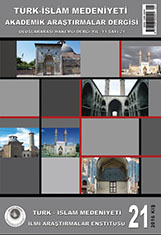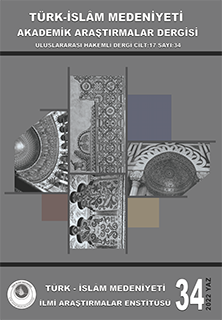What is Seljuk Architecture? Ambiguousness in Style and Semantic Legibleness of “Seljuk” Architecture
Keywords:
Anatolia, Medieval, Architecture, Seljuk, StyleAbstract
Some characterizations, taken as a reference which are preferred to recall an era, such as ‘Byzantine’, ‘Seljuk’, ‘Beylik’, ‘Ottoman’, are to identify a network of dull and unwieldy relationships through various resemblances, established between legacies of an era which is invented among the historical periods. Homogenised and idealized historical heritage via architecture has become the basic references of reading in general style. This text will search for ways of reframing style with regard to generate historical knowledge of architecture. In the context of criticism of a generalized reading mode such as style, it is thought that examinations, done by focusing on a period, accommodate both pertinent fields in order to generate fertile implications and tension lines which present spatial paths through timewise sections. Thereby, it is benefitted from a well-accepted characterization which is mentioned both narratives of academic canon and current popular discourses when concept of style transforms a simple way of ‘reading’ into a kind of a transposition which points out merely architecture itself. Ultimately it will be searched that concept of style, described by characterization of ‘Seljuk’ which reduces a fluid cultural milieu to a network of unwieldy relationships, should correspond to what kind of a translation and to what extent ‘Seljuk’ is an ambiguous characterization according to its stipes.
References
ACKERMAN, J.S., 1962, “A Theory of Style”, The Journal of Aesthetics and Art Criticism, 20(3), ss. 227-237.
AKIN, G., 2000, “Osmanlı Mimarlığı İle Diğer Sanatlar Arasındaki “Farklı Dil” Sorunu Üzerine Düşünceler”, Celal Esad Arseven Anısına Sanat Tarihi Semineri Bildirileri (7-10 Mart 1994), Mimar Sinan Üniversitesi Matbaası.
BLESSING, P. D., 2012, “Reframing the Lands of Rum: Architecture and Style in Eastern Anatolia, 1240-1320”, Princeton University, Department of Art and Archaeology, Doktora Tezi.
BOZDOĞAN, S., NECİPOĞLU, G., 2007, “Entangled Discourses: Scrutinizing Orientalist and Nationalist Legacies in the Architectural Historiography of the “Lands of Rum””, Muqarnas, XXIV,ss. 1-6.
CRANE, H., 1993, “Notes on Saldjuq Architectural Patronage in Thirteenth Century Anatolia”, Journal of the Economic and Social History of the Orient, 36(1), ss.1-57.
ÇELİK, Z., 1996, “Colonialism, Orientalism and the Canon”, The Art Bulletin, 78(2), ss. 202-205.
DE LANDA, M., 2013. Çev. Kılıç, E. “Çizgisel Olmayan Tarih”, İkinci Basım. Metis Kitabevi, İstanbul.
DOSTOĞLU, S., 1981, “Tarih, Mimarlık Tarihi ve Bazı Kavramlar”, Mimarlık
Dergisi, sayı: 165, ss. 7-11.
DOSTOĞLU, S., 1982, “Mimarlık Tarihi Üzerine Notlar”, Mimarlık Dergisi, sayı: 184, ss.11-14.
KUBAN, D., 1995, “Ortaçağ Anadolu-Türk Sanatı Kavramı”, Türk ve İslam Sanatı Üzerine Denemeler, Arkeoloji ve Sanat Yayınları, İstanbul.
LEACH, A., 2015, Çev. Doğan, H., “Mimarlık Tarihi Nedir?”, Koç Üniversitesi Yayınları, İstanbul.
MÜLAYİM, S., 1999, “Değişimin Tanıkları-Ortaçağ Türk Sanatında Süsleme ve İkonografi”, Kaknüs Yayınları.
PANCAROĞLU, O., 2007, “Formalism and the Academic Foundation of Turkish Art in the Early Twentieth Century”, Muqarnas, XXIV, ss. 67-78.
ÖZER, B., 2009, “Mimarlıkta Üslup, Batı ve Biz”, Kültür Sanat Mimarlık, YEM Yayın, İstanbul, ss.384-451.
THOMAS, J., 2000, “The Meaning of ‘Style’ in Traditional Architecture: the Case of Gothic”, The Journal of Architecture, 05(3), ss. 293-306.
TANYELİ, U., 2011a, “Rüya İnşa İtiraz Mimari Eleştiri Metinleri”, Boyut Yayıncılık, İstanbul.
TANYELİ, U., 2011b, “Bir Politik Tartışma Başlığı: Osmanlı’da Üslup Bütünlüğü”, Dosya, Sayı: 25,Ankara Mimarlar Odası Yayını, ss. 21-28.
WHYTE, W., 2006, “How Do Buildings Mean? Some Issues of Interpretation in the History of Architecture”, History and Theory, 45(2), ss.153-177.
WOLFFLIN, H.,1990, Çev. Örs, H., “Sanat Tarihinin Temel Kavramları”, Remzi Kitabevi, İstanbul.
Downloads
Published
How to Cite
Issue
Section
License
Copyright (c) 2016 TÜRK-İSLAM MEDENİYETİ AKADEMİK ARAŞTIRMALAR DERGİSİ

This work is licensed under a Creative Commons Attribution-NonCommercial 4.0 International License.







